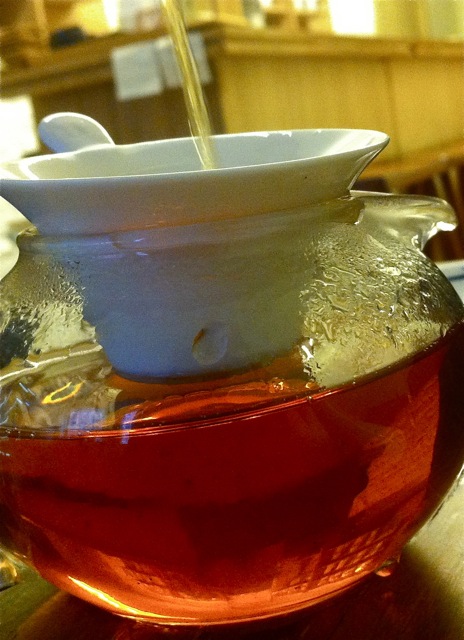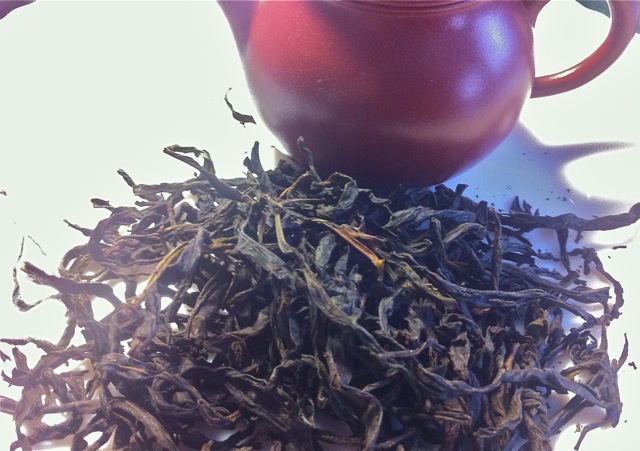Roasted Oolongs and the roast itself have long been a vital part of what the palate takes in. Roasting is a part of tea, a notion of tea that many westerners have had since schooners brought tea leaves back from the far ‘East’ to cups in the ‘West’ over the seas. Beyond heating and flavouring with specific kinds of heat, fragranced woods, charcoal, and controlled times, roasting is and always has been a way of enhancing and in some cases ‘hiding’ teas.
Oolong teas have long been flavoured, restored, burnt, and enhanced for centuries by those in the know and also by those hoping to profit. Roasting in the traditional sense is an art-form long performed by masters, who create something unique, and sometimes roasting is a stage performed by the desperate trying to salvage a harvest.
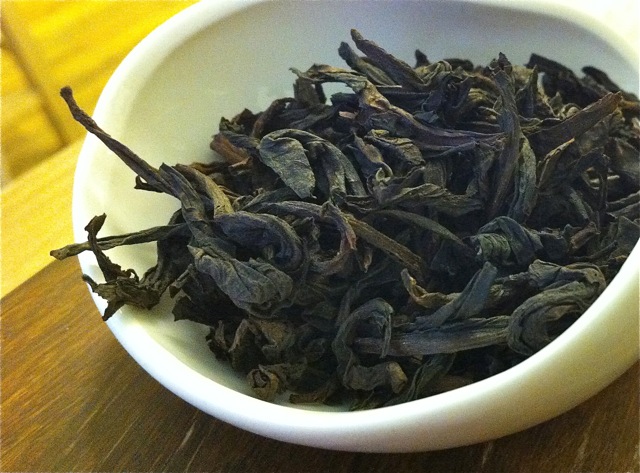
Long leaves, delicately roasted, and almost elegant the Shui Xian (at its best) is a gentle and narcotic roasted Oolong tea
In Japan roasting reaches a kind of pinnacle of deliberate manipulation that results in teas that – depending on the palate – can be something paradisiacal. Across the water to the southwest, an Oolong stone or cliff tea from Fujian province in China can reach a state of delicious delirium if the roaster is competent and has intention. In Taiwan there are Oolong tea makers that produce less than a half kg of something that is akin to a liquid panacea; of the soil itself, shared amongst only a few dedicates tucked away in a tiny tea house.
When a roast is something nefarious and slightly off-putting is when (and this is performed more often than many drinkers might think) the ‘roast’ is used for the very deliberate purpose of ‘re-infusing’ or breathing some flavour into a badly produced, very old, or disturbed tea. Roasting can in many ways ‘hide’ an inherent problem in a tea. Be it the taste of a tea, age, or simply questionable storage habits, the roast can salvage something perhaps best let go. An Oolong tea badly produced can hide easily in a roast or smoke dried process. Roasting can hide an atrociously produced tea as well. Legends – fact based and otherwise – run rampant in China about teas (that underwent ‘roasts’ or ‘smoke dried’ processes) that the west became enamored with, that no self-respecting local would touch, sip, or even consider.
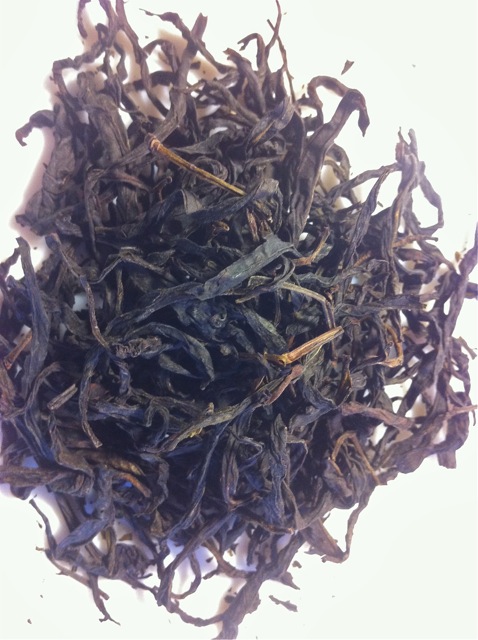
Powerful, dark, and almost risky, the Ru Gui is an Oolong tea that needs a delicate touch, otherwise it can assault the palate
Recently surrounded by snows, in a nice deviation from my precious raw Puerhs, I was gently reminded and inspired by what a roast ‘done well’ could be. The months of February and March were saturated by three roasted Oolongs that gifted the mouth and memory again and again. It was a series of tea sessions, sampling marvelously finished leaves that had been roasted to a gentle kind of glory.
A narcotic Shui Xian from Wuyi, a potent Ru Gui also from Wuyi and masterpiece of Taiwan, a small batch of Wushe Oolong from a friend, Mr. Lien. Mr. Lien considered roasting as an act of finessing and detailing, rather than obliterating a tea. He had laboriously hand-crafted this last of the three, the Wushe Oolong. The Ru Gui from Fujian province’s fabled Wuyi Mountain is another stunner though heavier and made to hit the mouth with power and jarring grip. The Shui Xian is less robust and traditionally carries a lighter almost subtle liquor of cedar.
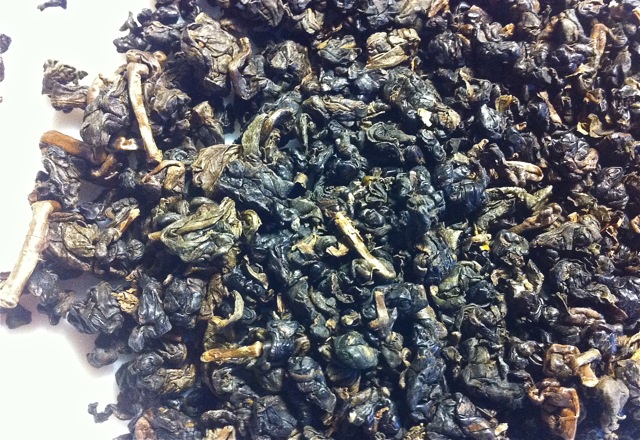
An Oolong tea custom roasted by a long-time friend, Mr. Lien, this tea goes into the lore of ‘one time, one pot, one tea’ – a rare classic
The roast in these three cases was applied not to hide any faults, but rather to enhance a traditional tea with an aroma and add another whole flavour value. The leaves used in the first place were cultivated with attention and an unerring ability. No inferior teas here, but rather stunning leaves, produced well, with a final little additional touch.
Roasts and roasters should be things of attention and subtlety rather than blunt heat trauma. “A gentle roast should enhance rather than blanket or obscure a tea” so says Mr. Lien from Taiwan, an uncompromising cultivator, producer, and sipper of Oolongs.
As with so much of the world of food and consumables there should be attention to the source, the creator, and ultimately the preparation of an Oolong tea. Mr. Lien once again seems to sum up so much wisdom in a few words, “Roasting is done in two ways: carefully, or without regard. Careful roasting is a tradition to infuse an already good tea with more flavour. Badly roasted tea is simply done to confuse and cover an already suspect tea”.
Roasting a tea is about temperature, time control, and ‘flavouring agents’. What Mr. Lien calls an “innocent roast” is simply expelling yet more moisture from the already ‘dried’ tea leaves and preparing the tea for ageing and storing. His “flavouring roast” on the other hand is about a very ‘trial and error’ method of using charcoal and/or certain types of fragrant woods to deliberately infuse a tea with other characteristics. Bamboo, pine, cypress, and all manner of different woods, including cherry can inundate a tea with their essence through careful roasting. While roasting itself is a subject that can be almost painfully loaded with details, the intention is usually simple: to expel moisture and humidity, and to further enhance and/or flavour. After a roast is done, the flavoured tea will then further develop in character taking months and perhaps years to get to its peak, whatever that peak happens to be.
A good friend once uttered the immaculately sage words that he much prefers drinking good tea, to philosophizing about and discussing good tea. Ponderous attention to detail, unpredictable palates, and vehement disagreement on methodology have long plagued the world of the leaf, he said. Teas were – in a perfect world – created by those who wanted to make something transformative and something eternal, so why spend too much time on the phrase-ology?
Though inevitably, whether a tea appeals or not is up to an individual palate, there should at least be a sense of how a classic ‘should’ taste or affect the palate, and particularly something as niche as a good roasted tea. Oolong teas are not the only to be soothed and tampered by roasts, but they are the most frequently altered by the process.
A Chinese tea farmer from Anhui had summed up his view of the world of roasted teas in another way: “It is something that only the skilled should do with a very good tea. The rest of us, should sit back and enjoy their labours”.

